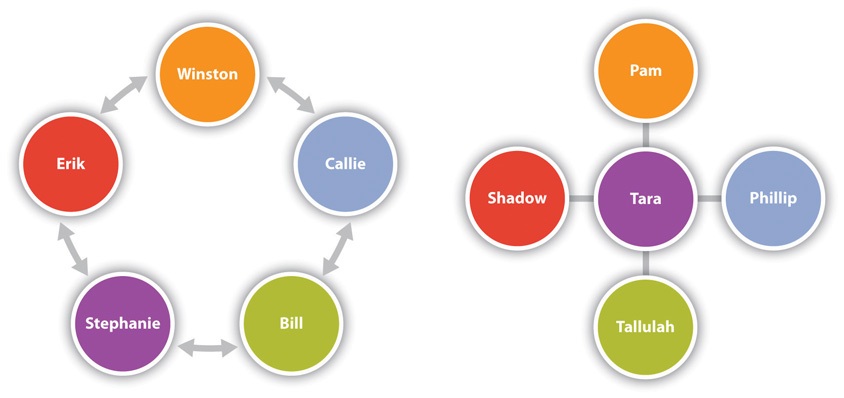Romantic Relationships and Social Networks
Social networks influence all our relationships but have gotten special attention in research on romantic relations. Romantic relationships are not separate from other interpersonal connections to friends and family. Is it better for a couple to share friends, have their own friends, or attempt a balance between the two? Overall, research shows that shared social networks are one of the strongest predictors of whether or not a relationship will continue or terminate.
Network overlap refers to the number of shared associations, including friends and family, that a couple has.Robert M. Milardo and Heather Helms-Erikson, “Network Overlap and Third-Party Influence in Close Relationships,” in Close Relationships: A Sourcebook, eds. Clyde Hendrick and Susan S. Hendrick (Thousand Oaks, CA: Sage, 2000), 33. For example, if Dan and Shereece are both close with Dan’s sister Bernadette, and all three of them are friends with Kory, then those relationships completely overlap (see Figure 7.3 "Social Network Overlap").
Figure 7.3 Social Network Overlap

Network overlap creates some structural and interpersonal elements that affect relational outcomes. Friends and family who are invested in both relational partners may be more likely to support the couple when one or both parties need it. In general, having more points of connection to provide instrumental support through the granting of favors or emotional support in the form of empathetic listening and validation during times of conflict can help a couple manage common stressors of relationships that may otherwise lead a partnership to deteriorate.Robert M. Milardo and Heather Helms-Erikson, “Network Overlap and Third-Party Influence in Close Relationships,” in Close Relationships: A Sourcebook, eds. Clyde Hendrick and Susan S. Hendrick (Thousand Oaks, CA: Sage, 2000), 37.
In addition to providing a supporting structure, shared associations can also help create and sustain a positive relational culture. For example, mutual friends of a couple may validate the relationship by discussing the partners as a “couple” or “pair” and communicate their approval of the relationship to the couple separately or together, which creates and maintains a connection.Robert M. Milardo and Heather Helms-Erikson, “Network Overlap and Third-Party Influence in Close Relationships,” in Close Relationships: A Sourcebook, eds. Clyde Hendrick and Susan S. Hendrick (Thousand Oaks, CA: Sage, 2000), 39. Being in the company of mutual friends also creates positive feelings between the couple, as their attention is taken away from the mundane tasks of work and family life. Imagine Dan and Shereece host a board-game night with a few mutual friends in which Dan wows the crowd with charades, and Kory says to Shereece, “Wow, he’s really on tonight. It’s so fun to hang out with you two.” That comment may refocus attention onto the mutually attractive qualities of the pair and validate their continued interdependence.
“Getting Plugged In”
Online Dating
It is becoming more common for people to initiate romantic relationships through the Internet, and online dating sites are big business, bringing in $470 million a year.Mary Madden and Amanda Lenhart, “Online Dating,” Pew Internet and American Life Project, March 5, 2006, accessed September 13, 2011,http://www.pewinternet.org/~/media//Files/Reports/2006/PIP_Online_Dating.pdf.pdf.Whether it’s through sites like Match.com or OkCupid.com or through chat rooms or social networking, people are taking advantage of some of the conveniences of online dating. But what are the drawbacks?
- What are the advantages and disadvantages of online dating?
- What advice would you give a friend who is considering using online dating to help him or her be a more competent communicator?
Interdependence and relationship networks can also be illustrated through the theory of triangles(see Figure 7.4 "Theory of Triangles"), which examines the relationship between three domains of activity: the primary partnership (corner 1), the inner self (corner 2), and important outside interests (corner 3).Stephen R. Marks, Three Corners: Exploring Marriage and the Self (Lexington, MA: Lexington Books, 1986), 5.
Figure 7.4 Theory of Triangles

All of the corners interact with each other, but it is the third corner that connects the primary partnership to an extended network. For example, the inner self (corner 2) is enriched by the primary partnership (corner 1) but also gains from associations that provide support or a chance for shared activities or recreation (corner 3) that help affirm a person’s self-concept or identity. Additionally, the primary partnership (corner 1) is enriched by the third-corner associations that may fill gaps not met by the partnership. When those gaps are filled, a partner may be less likely to focus on what they’re missing in their primary relationship. However, the third corner can also produce tension in a relationship if, for example, the other person in a primary partnership feels like they are competing with their partner’s third-corner relationships. During times of conflict, one or both partners may increase their involvement in their third corner, which may have positive or negative effects. A strong romantic relationship is good, but research shows that even when couples are happily married they reported loneliness if they were not connected to friends. While the dynamics among the three corners change throughout a relationship, they are all important.
KEY TAKEAWAYS
- Romantic relationships include dating, cohabitating, and partnered couples.
- Family background, values, physical attractiveness, and communication styles influence our attraction to and selection of romantic partners.
- Passionate, companionate, and romantic love and sexuality influence relationships.
- Network overlap is an important predictor of relational satisfaction and success.
EXERCISES
- In terms of romantic attraction, which adage do you think is more true and why? “Birds of a feather flock together” or “Opposites attract.”
- List some examples of how you see passionate and companionate love play out in television shows or movies. Do you think this is an accurate portrayal of how love is experienced in romantic relationships? Why or why not?
- Social network overlap affects a romantic relationship in many ways. What are some positives and negatives of network overlap?